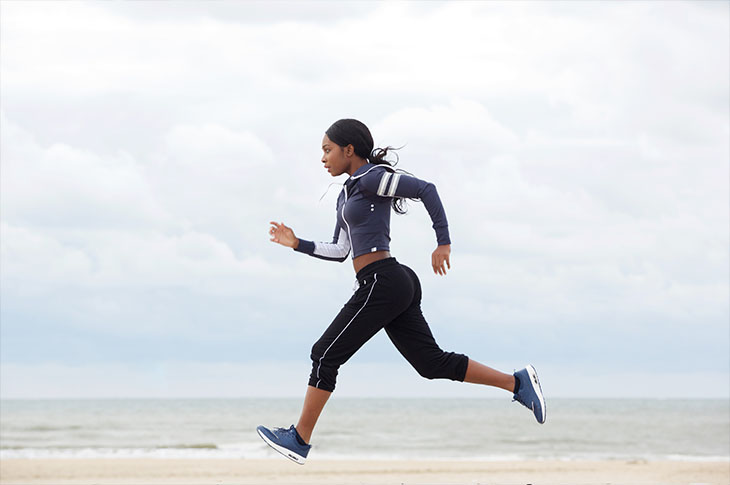
Spending time at the beach is an opportunity for some much-needed relaxation. It can also be a great place to work out. You don’t even need to face the waves, bust out burpees on the sand, or lace up your sneakers—a walk on the beach is an excellent cardio session.
“The sandy surface makes each step difficult to take, so you need to activate more stabilizing muscles. This results in burning more calories than if you were walking the same distance on a sidewalk,” explains certified personal trainer Josh Schlottman, CSCS. Plus, you can make the walk as easy or challenging as you’d like. Whatever your goal, use the following expert tips to stay safe and maximize the benefits of your beach workout.
Start slow. Unless you live at the shore, your body likely is used to walking on stable surfaces, not sand. And as with any new workout, using muscles you don’t normally recruit very much can lead to soreness or even injury if you do too much too soon. Most trainers recommend beginning with 15- to 30-minute walks. You may feel great during the workout and think you can do more, but don’t push it—you’ll likely be sore in unusual places the next day. As your body adapts, go for longer walks or do one walk in the morning and one in the afternoon.
Shoes are up to you. If you feel fine barefoot, go for it. “Foot strength is really important. The correct utilization of our toes and the muscles in our feet has huge impacts on knee stability, calf activation, and hip stability,” says personal trainer Brett Durney, founder of London’s Fitness Lab. That said, sand often houses pieces of shells, jellyfish, and other potentially painful objects, so you may prefer to wear shoes. In that case, try minimalist shoes so you can protect your feet and get the stability-boosting benefits of beach walking.
Mix up hard and soft sand. Both have different perks: Beginners and speed walkers may prefer hard sand, which is easier to walk on. Once you feel good with that, consider spending some time on softer sand too. Since this provides extra resistance and is more demanding, you’ll fatigue faster but remember, you’re also working more stabilizer muscles. “If you’re looking to optimize your overall health, a combination of soft and hard sand will allow your body to be challenged against all surfaces, and it will avoid overtraining one specific muscle,” adds Lizzie May, a YMCA level 3 personal trainer.
Mind the slant. Beaches aren’t pancake flat, and depending on where you walk, there may be quite a slope. If you only go in one direction, this can increase the risk of muscle strain or imbalances. Luckily, an out-and-back walk easily prevents problems since you’ll recover the same surface from the opposite direction.
Don’t forget to stretch. Beach walking particularly works your calves and hips, so be sure to include a few post-workout stretches. Durney recommends the following:
- Gastrocnemius stretch: Stand on a curb or step with both feet. Keeping one foot level, drop the heel of the other foot to create a stretch down that calf. Hold for 30 to 45 seconds, then switch sides.
- Hip flexor stretch: From kneeling, place one foot forward to come into a kneeling lunge position. Place your hands on the back of your hips and gently push forward as you tilt your pelvis toward your nose to create a posterior pelvic tilt. Contract the glute muscles of your back leg to increase the stretch further. Hold for 30 to 45 seconds, then switch sides.
- Cat/cow: Come to all fours with knees under hips and hands under shoulders. Inhale, then, on an exhale, round your back while tucking your pelvis and dropping your head (think of an upside-down crunch). This is cat. On your exhale, return to a neutral spine, then lift your chest and tailbone upward simultaneously. This is cow. Continue to alternate between the two, only going as far as is comfortable.
Roll your feet. If the bottoms of your feet are sore afterward, use a tennis ball to roll them out and find relief, recommends certified personal trainer Sergio Pedemonte, CEO of Your House Fitness.
Skip beach walks if… Walking on the beach may aggravate any foot, hip, knee, or back issues. If you fall into any of these categories, talk to your doctor or a physical therapist before taking a stroll as a workout.
Challenge yourself. “Walking on the beach with a goal destination and time can make the workout fun, challenging, and will encourage you to maintain your pace,” Pedemonte says. Once you feel comfortable, pick a goal and go for it.
This information is for educational purposes only and is not intended as a substitute for medical diagnosis or treatment. You should not use this information to diagnose or treat a health problem or condition. Always check with your doctor before changing your diet, altering your sleep habits, taking supplements, or starting a new fitness routine.

If you have questions about a Fitbit tracker, product availability, or the status of your order, contact our Support Team or search the Fitbit Community for answers.
Please note: Comments are moderated and may not appear immediately after submission.